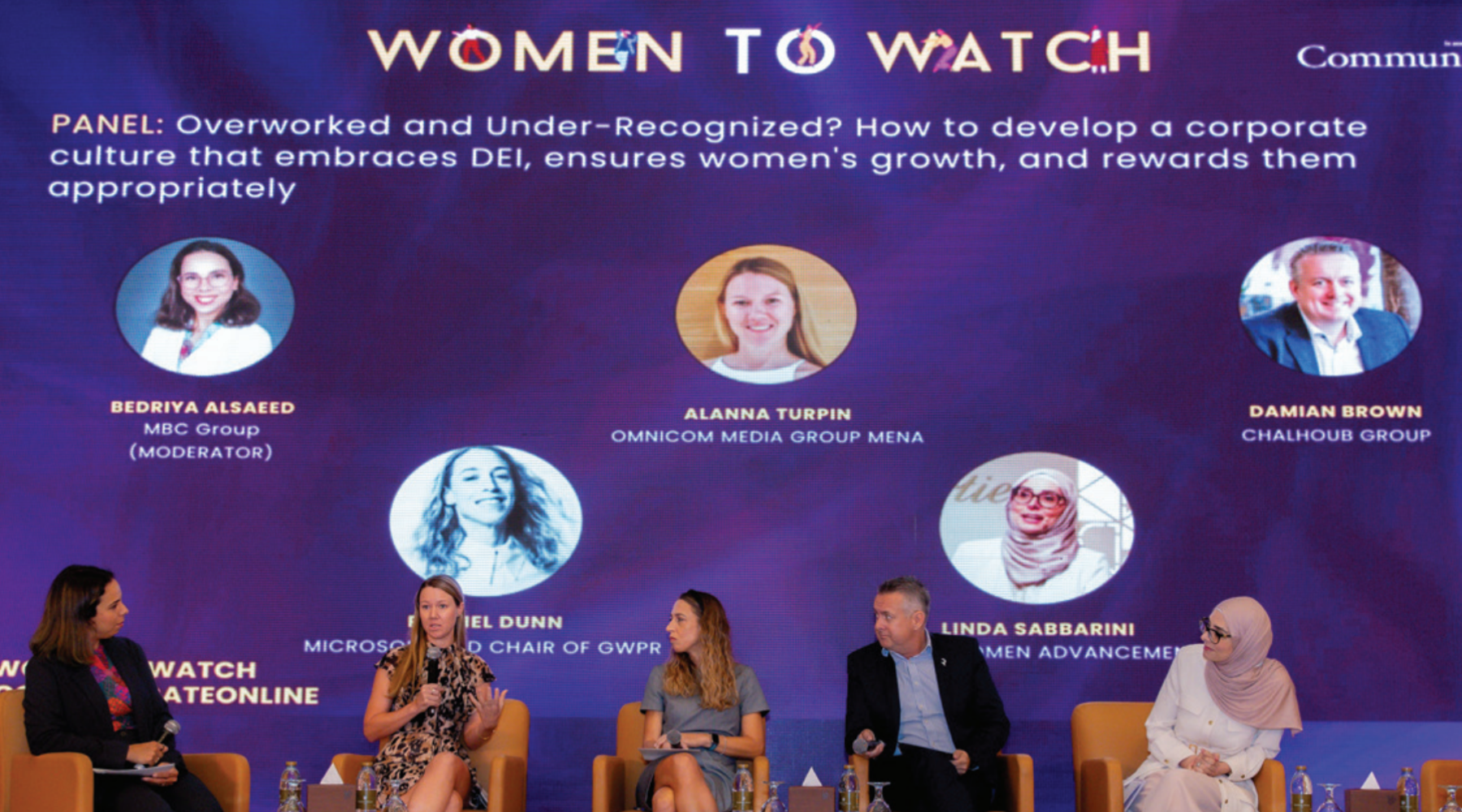The discussion dives into the obstacles organizations are facing today in actioning on DE&I policies and how they can effectively address the cause behind them.
Why is it so important to define the terms – diversity, equity, and inclusion?
Bedriya Alsaeed, Employee Engagement Manager and DEI Lead at MBC Group: Our goal at MBC is to foster a culture where everyone feels emotionally and psychologically safe, where they can bring their best selves and be seen and heard. This outlook has evolved significantly from when I first started years ago. I vividly remember a particular incident that I believe many can relate to. I was sitting in the HR department with a colleague when the MD walked in. He was looking for the HR director, a successful woman. Instead of addressing her by her name, he asked for her using a very unprofessional and disrespectful term. At the time, I smiled and informed him of her whereabouts, not fully realizing the derogatory and inappropriate nature of his comment.
Looking back, I now understand the impact it had on a young individual starting her career in a large corporate environment. It made me question my sense of belonging, as these terms were disrespectful and reinforced gender stereotypes. Sharing this experience reminds us of the importance of addressing gender equality within the broader context of diversity and inclusion. While DEI encompasses various elements such as age, race, and religion, it is crucial to acknowledge that gender inequality still persists in many workplaces today.
Linda Sabbarini, Gender Consultant at NAMA Women Advancement: As a gender specialist, I emphasize the significance of aligning on definitions because, regrettably, there is still a misconception surrounding them, leading to their interchangeable use. This lack of clarity hinders our mission from achieving the desired results since we do not possess the necessary knowledge of what each term truly signifies. Gender equality translates to equal rights, responsibilities, and opportunities for all individuals – it’s not about expecting women and men to be identical. On the other hand, gender equity focuses on promoting fairness and justice.
Historically, there has been significant bias and discrimination against women, leading to a substantial gender gap. As a result, it is crucial to implement equitable measures that enable women to unleash their potential. It’s not a question of incompetence; rather, they require additional support due to the long-standing discrimination they have faced. Regarding gender expertise, we were initially skeptical about including it within the broader DE&I framework because we believe gender deserves its own separate focus. Gender should be addressed as a distinct aspect because, within its scope, we can address diversity. If not handled properly, the intersectionality of gender and diversity can give rise to compounded biases and discrimination.
Alanna Turpin, Director – Sustainability and Culture at Omnicom Media Group MENA: Everyone agrees that we should be treated equally, and indeed, we should. However, it’s important to recognize that not everyone is the same. Therefore, we must consider equity and examine how, when, why, and whom we should uplift. The goal is to ensure that individuals have equal viewpoints, experiences, and opportunities. There seems to be a common misunderstanding when it comes to diversity. Just yesterday, I had a conversation with a colleague from my company’s people team. He stated that diversity is solely a recruitment issue. I challenged his perspective by asking if he conducts interviews for our organization. Given his mid-level position, he admitted that he does. Well, then it’s also his responsibility to address his own biases in the recruitment process. The task of promoting diversity falls upon all of us; it is everyone’s role and responsibility. Thus, it is crucial to have clear definitions in any corporate, public, private, or NGO setting.
How does gender equality fall under the ESG pillars? How are large organizations embracing this globally and how is this having a domino effect on the whole ecosystem, such as agency networks, particularly with the year of sustainability in the UAE?
Alanna Turpin: I have been with Omnicom Media Group in this role for eight years, initially starting my journey here as the CSR manager and gradually transitioning into sustainability. Finally, I am witnessing sustainability gaining traction in the region. While this is partly due to the EU Sustainability efforts, the topic has garnered significant attention since the announcement of COP28, which is set to take place at the Dubai Expo in November 2023. Now, DE&I actually forms a part of ESG, the social elements, with ‘E’ being Environmental, ‘S’ being how you look after your people’s Social, and community needs, and ‘G’ being Governance which reflects your ethics of conducting business with transparency. We’re seeing a lot of multinationals walking down this lane of building an ESG framework.
Last week, I received a comprehensive survey from a regional holding company, which they are sending to all their suppliers, including us. It’s part of their initiative to audit the entire supply chain, and they have engaged a third party to conduct the audit annually at our own expense. The survey covers various aspects of our operations, focusing on intricate details and practices related to our workforce. This trend is not limited to the region; globally, agencies like ours are being pushed by multinational corporations (MNCs) to comply with these sustainability measures. Whether we embrace it or not, we will all have to actively participate in this movement. Sustainability is now a driving force behind the DE&I agenda in our industry.
Rachel Dunn, Communications Director MEA (Chair of GWPR) at Microsoft: It is crucial for diversity, equity, and inclusion to be deeply embedded in the organizational culture. This responsibility extends to everyone, regardless of their position or level within the company. By creating a truly inclusive culture with clear values, goals, and behaviors linked to diversity, equity, and inclusion, we ensure that everyone understands their role and contribution. It is no longer solely the responsibility of leadership or managers; every individual has an important part to play. This applies to multinational corporations, government organizations, and even small start-ups. Diversity, equity, and inclusion are no longer seen as a 'nice-to-have' but rather as essential elements that need to be infused throughout the entire organization.
In that context, why is it critical to approach gender equality in the workplace? How can we remove obstacles while giving everybody a fair chance, rather than artificially recruiting or promoting women to simply tick a box?
Damian Brown, Group Head of Talent at Chalhoub Group: As a father of two young daughters, I agree with the discussion on the generational challenge of achieving gender equality. While gender barriers have been somewhat bridged for today’s youth, I believe in giving gender the table stakes as a part of the DE&I discussion. At Chalhoub Group, we started with equal representation between a man and a woman 72 years ago, and we have been striving to maintain that balance ever since. Currently, around 30% of our leadership positions are held by women, and we have achieved this through implementing quotas. However, we have always been committed to ensuring that the skill set is never compromised in the process.
For instance, when we aimed to hire women for specific roles in our boardroom, we took an entire year to find the right candidates because we refused to resort to tokenism. Consistency within the business is crucial. It’s not just a checkbox; we must consistently apply our promotion criteria to ensure that individuals do not feel like opportunities are handed out based on gender. Internally, maintaining this consistency is the most important aspect of achieving equity and ensuring equality. We also place significant emphasis on measuring these aspects regularly. Through live Power BI dashboards provided by Microsoft, we monitor gender parity in terms of pay, turnover, attrition, promotions, and raises. This constant measurement allows us to correct and address any biases that may exist among certain leaders by providing them with the necessary re-education.
Linda Sabbarini: I appreciate the private sector’s mindset because, as a gender equality advocate, I strongly oppose the concept of parachuting, which refers to the practice of placing women in positions they don’t deserve simply to meet a quota. That’s not what we advocate for. We ask for gender mainstream policies and procedures within organizations. We ask organizations to consider the distinct needs of both men and women when planning and implementing these policies and procedures. It’s not just about creating plans; it’s about fostering the right organizational culture that enables both genders to thrive. It’s not a battle; it’s about creating an inclusive environment where everyone can succeed.
How can organizations ensure that policies translate into meaningful actions involving and recognizing everybody, regardless of gender and seniority?
Alanna Turpin: I believe that larger companies like Microsoft should have KPIs in place to ensure fairness, impartiality, and gender neutrality. But, there’s one place where we all need to start, and in full honesty, we, at Omnicom Media Group, are still on the journey and have not yet achieved that level. That is to create awareness among individuals about their unconscious biases, have open conversations, and provide training to leadership and employees to make them conscious of these biases and their impact.
Currently, we are actively involved in the DE&I space through our participation in organizations like the Middle East Inclusion and Diversity Council and the Unstereotype Alliance. However, we are now focusing on what more we can do internally. We are making a deliberate effort to engage with our leadership, provide training, and raise awareness about unconscious bias, starting from the basics. Only after creating this foundation of awareness can we gradually integrate it into our KPIs. It’s crucial to ensure that our goals and efforts align authentically, avoiding a mismatch between our objectives and the true values we aim to uphold.
Rachel Dunn: There is no ‘one size fits all’ approach. There is no immediate silver bullet. Organizations need to articulate a specific DE&I goal for their business and have a tangible impact on the business outcomes. But I believe it goes beyond that. Each of us, not only as employees of a company but also as parents, members of industry organizations, and part of broader networks, have a role to play. It extends beyond company policies. Governments, too, have a responsibility to implement regulatory policies that drive widespread adoption and support a more inclusive and fair society. The private sector is just one piece of the puzzle.
It is important for companies to collaborate with industry bodies and government entities to learn from and share best practices, as well as address specific challenges faced by different industries. For example, in the tech industry, there is a need to focus on initiatives that encourage coding and STEM education for young girls and children. In the marketing and communications industry, programs like the 'Think Equal' initiative aim to support women in transitioning from middle management to senior leadership positions. Therefore, the responsibility lies not only with companies but also with individuals, industry bodies, and government entities. It is a collective effort that goes beyond policies, requiring collaboration and adherence at various levels.
What are the most common barriers women face when progressing to senior positions, and what can organizations do to support them from both a culture and leadership perspective?
Rachel Dunn: For me, it’s not solely about the amount of time spent on DE&I initiatives or campaigns. It goes beyond that—it’s about behavioral change and how we show up as role models. Simply measuring the time spent on DE&I initiatives is too limited. Instead, we should consider how individuals demonstrate inclusive behaviors in the workplace. Some men may not actively engage in DE&I initiatives, but if they role model inclusive behaviors and align with the organization’s values, that can be just as impactful. When discussing challenges and opportunities, there can be a tendency to have repetitive conversations without enough action. It’s important to avoid fatigue where discussions become stagnant, and action is lacking. Whether addressing gender diversity or diversity of perspectives, it’s crucial to identify and prioritize the most pressing challenges and actively pursue solutions. It’s about focusing on actionable steps rather than merely talking about the issues at hand.
Damian Brown: The lack of role models can be a challenge in many organizations. I consider myself lucky to work in HR where we have achieved great gender balance over the years. Having role models is crucial because they inspire others and show that reaching the boardroom is possible. It’s equally important to have a supportive peer group in the boardroom because being the only one can hinder growth. Creating a peer group, implementing peer-to-peer coaching, and fostering a movement within the organization are some of the steps we should be taking. Measurement is also essential. Starbucks did an excellent job several years ago when they tied 20% of everyone’s bonus to DE&I reporting. It led to rapid changes in behavior when people’s pay was affected. Similarly, at our company, DE&I commitment is part of the annual review process, and we look for tangible outcomes. Rather than just identifying problems, we focus on enabling individuals to create equity and inclusion, allowing them to learn and grow on their own journey.
This piece was first published in Communicate's Women to Watch Issue 2023.






